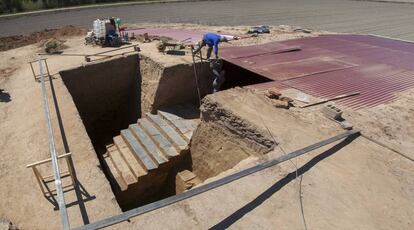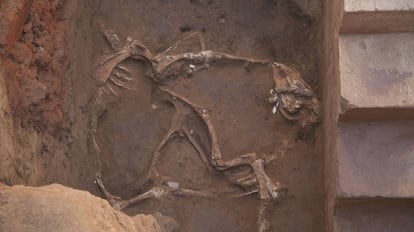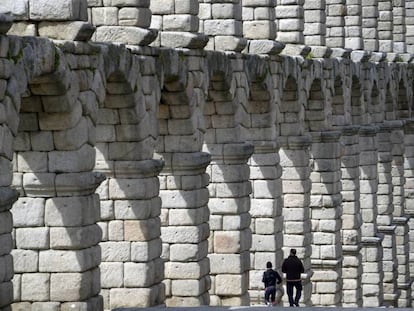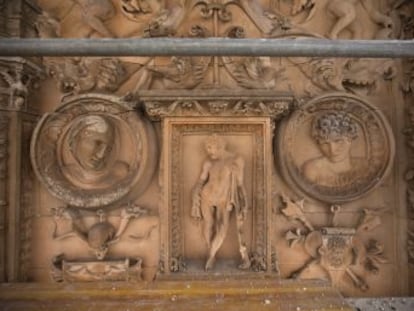Spanish dig uncovers unique building from mysterious Tartessos culture
Two-floor construction was used for a feast before being razed by its own dwellers ahead of invasion


Without the proper context, the sight of a staircase leading down into a great hole in the ground might not look like much. But this hole is part of an archeological dig that has uncovered an enormous building dating back 2,500 years, part of the famed Tartessos culture. The find was made in the western Spanish region of Extremadura, a rural land renowned for its cork oak plantations, its scorching summers, and for being the birthplace of conquistadors.
In the fifth century before the Christian era, there was a massive two-story building standing here, in the demarcation of Las Vegas del Guadiana, in Badajoz province. The building ¨C the first surviving one of its kind from that era to be discovered ¨C had a monumental staircase rising two-and-a-half meters. And it was made with materials and techniques that researchers thought had not been in use in the Western Mediterranean until much later.
There was a great celebration held at the site, right before the building was destroyed
Half of the steps were made by stacking up large, rectangular blocks, but the builders did not use hewn stone as the Greeks did. Instead, they used a mortar made with calcium oxide and powdered granite, which was probably poured into molds, in something like an early form of cement. Except that this took place a full century before the first documented cement-like material, opus caementicium, began to be used in the Roman Empire.
The Turu?uelo de Guare?a site, where digging began in 2015, has already yielded several surprises because of its sheer size (at one hectare, it is the biggest known Tartessian-era site), the wealth of the artifacts that have turned up, and their extraordinary state of conservation.
All kinds of jewelry, lance tips, containers, seeds, fabric fragments, bronze grills and enormous pots have emerged from the earth, promising to shed new light on a pre-Roman civilization that occupied the southwest of the Iberian peninsula in the first millennium before the Christian era.

All kinds of myths and legends have sprung up around the Tartessians, particularly because of their mysterious decadence and abrupt end. This is partly due to the shortage of physical evidence that they left behind. But a team led by two archeologists from Spain¡¯s Higher Center for Scientific Research (CSIC), Esther Rodr¨ªguez and Sebasti¨¢n Celestino ¨C who is also director of the M¨¦rida Archeology Institute ¨C is fast making up for the dearth of Tartessian cultural remains. And only 10% of the building has been unearthed so far.
¡°A staircase is a unique architectural element of something that we didn¡¯t think they were capable of executing,¡± explains Rodr¨ªguez. ¡°There were stairs in use during the Peninsula¡¯s early history, but at a later date. All we were aware of from this period was the odd set of two or three stone-and-adobe steps to make up for the sloping ground.¡±
In this case, however, there are at least 10 steps (more could still turn up) measuring over two meters across, 40 centimeters wide and 22 cm high. The top five steps are covered with slabs of slate, and the bottom ones are made with the granite-and-lime mortar described earlier.
A staircase is a unique architectural element of something that we didn¡¯t think they were capable of executing
Esther Rodr¨ªguez, dig co-director
¡°The most surprising part was its depth,¡± adds Celestino. ¡°Two-and-a-half meters means that there is another floor underneath, and that we are now accessing the top floor.¡±
There had been some speculation as to the existence of these types of buildings during Tartessian times, based on biblical descriptions. But none had ever been found. ¡°This will be the first building to conserve both floors,¡± says Celestino.
To one side of this astounding staircase, archeologists found the bodies of two horses placed in an anatomical position, wearing all of their apparel, which clearly suggests a ritual sacrifice: these animals were a sign of luxury at the time, and not killed for food. On the other side of the staircase, however, there are the remains of a cow, which dwellers apparently feasted on.
All of the above has investigators positing that there was a great celebration held at the site, right before the building was destroyed.
Most of the buildings from the era were located in the middle valley of the Guadiana River, an area that went through a deep economic crisis in the 6th century BC, then sustained large waves of immigration emanating from the central nucleus of Tartessos on the Guadalquivir, in modern-day Huelva. In the late 5th or early 4th century, faced with the imminent arrival of Celtic tribes from the north, the local residents decided to raze their own buildings rather than watch them get pillaged by the invaders.
The building in Turu?uelo de Guare?a was set on fire and buried under layers of mud retrieved from the riverbed of the Guadiana. But its formidable structure, with walls several meters deep, allowed it to remain standing in spite of everything.
This building has some of the traits of a palace, but also of a great funeral monument
Now, the excavation team ¨C whose work has the backing of regional and local authorities, and financial support from the province of Badajoz ¨C will keep plumbing the depths of this gigantic construction. The next effort will take place in May, when researchers will attempt to understand what the building was used for, and what the farewell celebration was like.
There is an added difficulty in that this is uncharted territory: the building is unlike any other Tartessian construction found in the area so far, such as the sanctuary of Cancho Roano in Zalamea de la Serena; or La Matain Campanario, which played more of an economic role. This building has some of the traits of a palace, but also of a great funeral monument.
¡°The upper level, with its various altars, has a crystal-clear ritual function, but religion was mixed in with everything else back then,¡± explains Celestino. ¡°There are elements that make one think about burials, such as the fact that there are no built floors, despite the lavishness of every other element. Yet the fact that there were two floors suggests something else.¡±
The answers will come when the other 90% of the building emerges from amid the fields of tomato plants in Las Vegas del Guadiana.
English version by Susana Urra.
Tu suscripci¨®n se est¨¢ usando en otro dispositivo
?Quieres a?adir otro usuario a tu suscripci¨®n?
Si contin¨²as leyendo en este dispositivo, no se podr¨¢ leer en el otro.
FlechaTu suscripci¨®n se est¨¢ usando en otro dispositivo y solo puedes acceder a EL PA?S desde un dispositivo a la vez.
Si quieres compartir tu cuenta, cambia tu suscripci¨®n a la modalidad Premium, as¨ª podr¨¢s a?adir otro usuario. Cada uno acceder¨¢ con su propia cuenta de email, lo que os permitir¨¢ personalizar vuestra experiencia en EL PA?S.
?Tienes una suscripci¨®n de empresa? Accede aqu¨ª para contratar m¨¢s cuentas.
En el caso de no saber qui¨¦n est¨¢ usando tu cuenta, te recomendamos cambiar tu contrase?a aqu¨ª.
Si decides continuar compartiendo tu cuenta, este mensaje se mostrar¨¢ en tu dispositivo y en el de la otra persona que est¨¢ usando tu cuenta de forma indefinida, afectando a tu experiencia de lectura. Puedes consultar aqu¨ª los t¨¦rminos y condiciones de la suscripci¨®n digital.










































